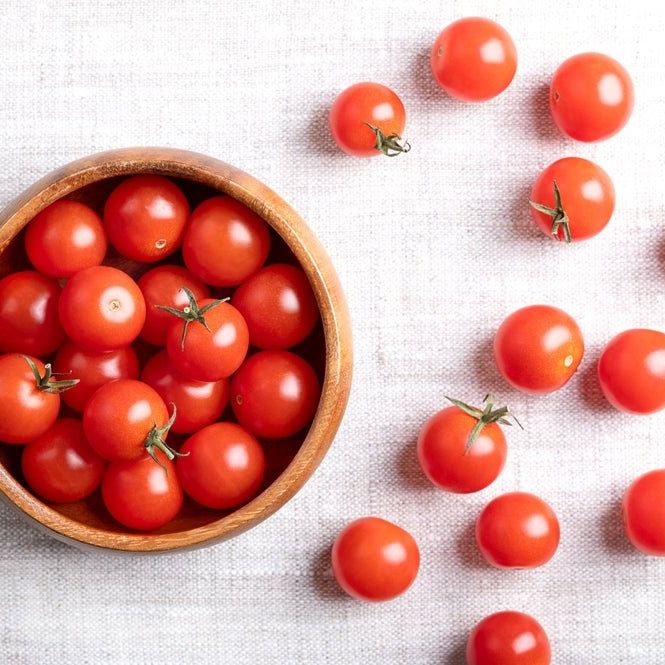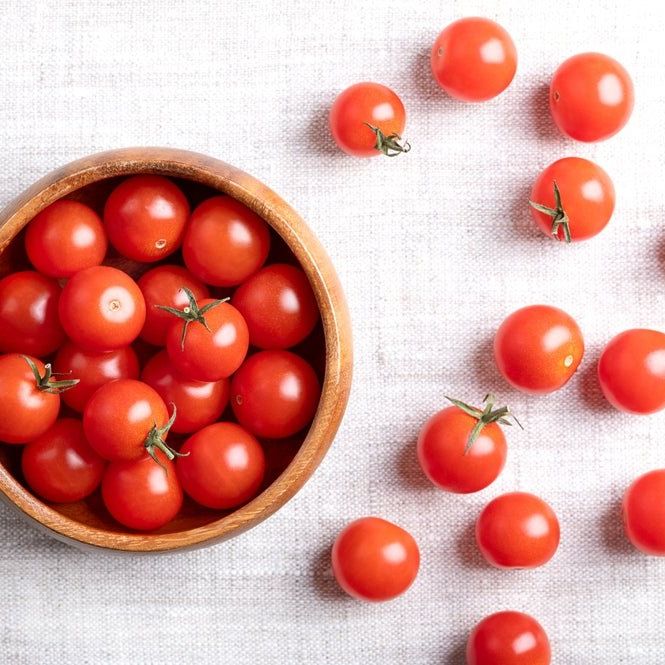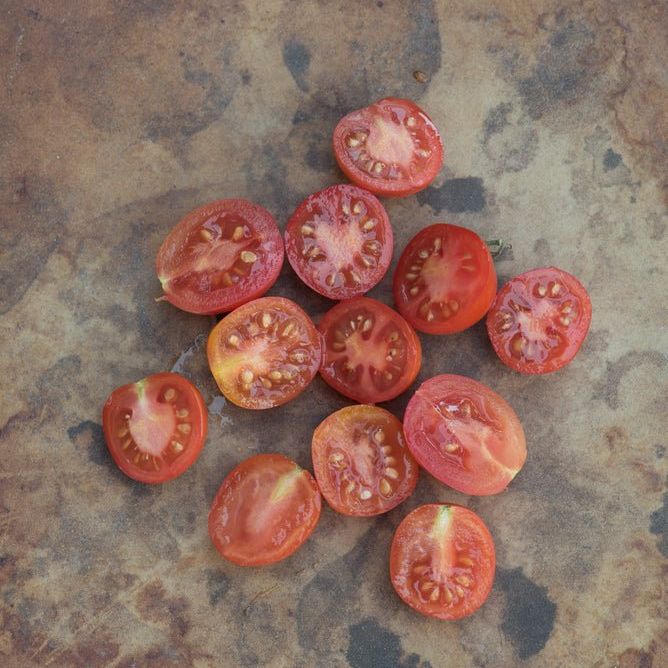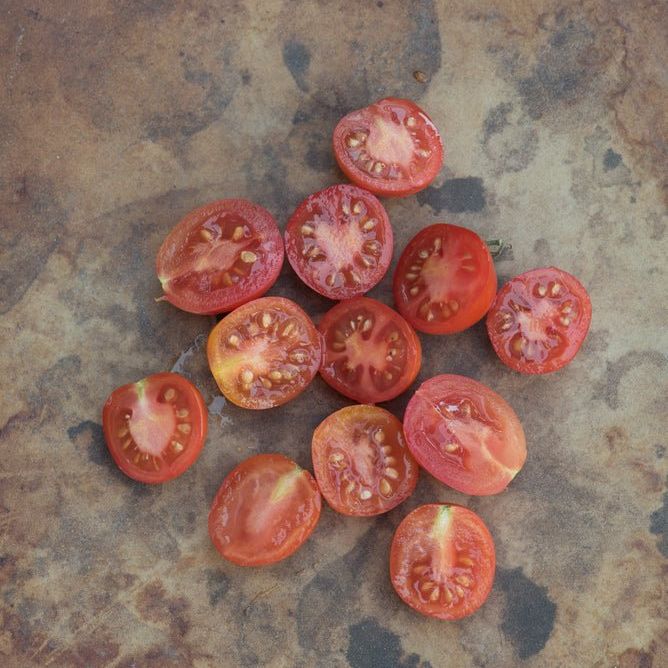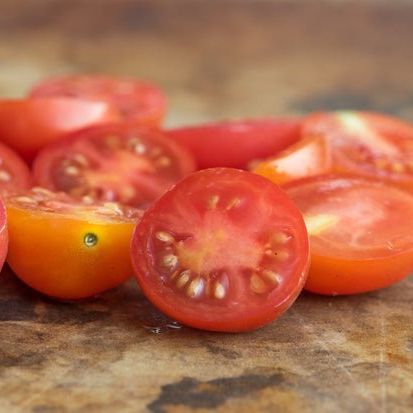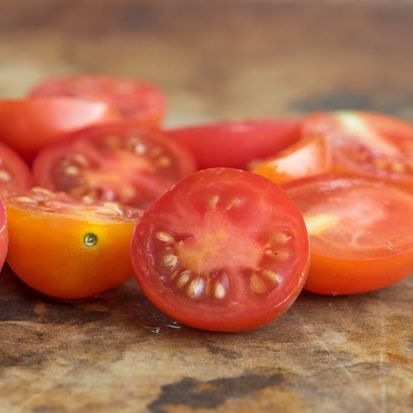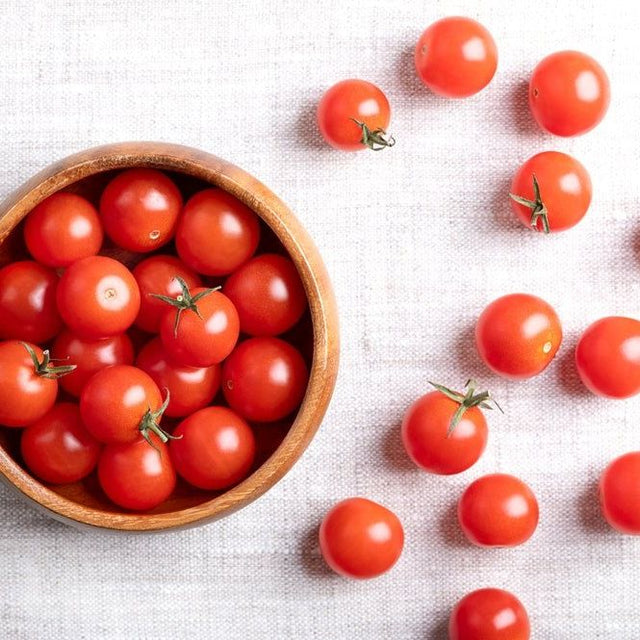Tomato Seeds - Indeterminate - Matt's Wild Cherry
Vigorous, disease-resistant vines yielding bursts of candy-sweet wild cherry fruit.
- Non-GMO Safe Seed Pledge
- Seed packets printed on forestry-certified paper (FSC, SFI, Rainforest Alliance)
- Curbside-recyclable mailers; SFI-certified kraft paper
- 1% for the Planet partner — supports environmental nonprofits
- Compact, energy-efficient facility with lean, low-waste operations
- Seeds: When properly stored, planted, and cared for, we guarantee reasonable germination and true-to-type growth for one year from purchase.
- Non-seed products: Free from defects in materials and workmanship for 30 days from shipment.
Excludes factors outside our control (extreme weather, pests, gardener error). If something’s off, contact us—we’ll make it right with a replacement, repair, or refund.
We do not sell seeds that are GMO or BE.
USDA “bioengineered (BE)” foods are those with detectable genetic material that was modified using in vitro recombinant DNA (rDNA) techniques, in ways not obtainable through conventional breeding or found in nature. The USDA’s National Bioengineered Food Disclosure Standard uses “bioengineered” as the nationwide labeling term.
- Detectable modified genetic material in the final food
- Created via in vitro rDNA techniques (e.g., gene transfer)
- Modifications not achievable through conventional breeding or nature
Description
The Matt’s Wild Cherry Tomato is a vigorous, naturally resilient heirloom believed to trace back to wild tomato strains from the Mexican highlands, where Indigenous farmers first domesticated Solanum lycopersicum. This variety embodies the essence of those original tomatoes—tiny, ruby-red fruits bursting with intense, complex sweetness and bright acidity.
Maturing in just 55–65 days, the fruits measure about ½ inch across, growing in abundant clusters that continue producing until frost. Their bold, candy-sweet flavor with a zesty undertone makes them exceptional for snacking, salads, and market display. The fruit’s thin skin and juicy flesh capture the true spirit of the tomato’s ancient, untamed origins.
Plants are indeterminate and sprawling, often exceeding 6 feet in height with prolific branching. They require staking or caging to support their vigorous growth but reward the gardener with near-continuous harvests. Naturally disease-tolerant and crack-resistant, Matt’s Wild Cherry performs beautifully in diverse climates and is especially valued for its pollinator appeal and stress resilience.
This tomato’s history runs deep—it was collected from Hidalgo, Mexico, and later introduced into U.S. seed circles by the University of Maine. Today, it stands as both a botanical heirloom and cultural bridge, linking modern gardens with the genetic legacy of the first tomato seedkeepers of Mesoamerica.
Your payment is processed securely via trusted gateways. We do not store credit card details and we do not have access to your card information.
Couldn't load pickup availability
1. Choosing the Right Location
Light Requirements:
Tomatoes are sun-loving plants that require at least 6–8 hours of direct sunlight daily, though 8–10 hours is ideal for strong fruit set and flavor. Choose a site with full southern exposure whenever possible. Avoid shaded areas near trees, fences, or tall crops. Plants grown in partial sun may produce leggy growth and fewer fruits.
Soil Requirements:
Tomatoes thrive in well-drained, loamy soil enriched with organic matter. The optimal pH range is 6.0–6.8, though they tolerate slightly acidic conditions. Prepare beds ahead of time by incorporating aged compost, leaf mold, or well-rotted manure to improve structure, fertility, and microbial activity.
Avoid compacted or waterlogged soil, which restricts root growth.
Sandy soils warm faster and suit early crops; heavier soils retain moisture better in dry climates.
Rotate planting sites annually to prevent nutrient depletion and disease buildup.
Soil Preparation Tip:
Before sowing or transplanting, loosen the top 8–12 inches of soil and blend in 2–3 inches of organic compost. If needed, amend with bone meal for phosphorus and greensand or kelp meal for potassium to promote strong roots and flowering.
2. Starting Seeds Indoors
Timing:
Sow tomato seeds 6–8 weeks before the final expected frost date. Adjust timing to your region so that transplants are ready to go outside once the soil has warmed to at least 60°F (16°C) and nighttime temperatures remain above 50°F (10°C).
Containers and Medium:
Use clean trays or small pots filled with a sterile, fine-textured seed-starting mix. Avoid heavy garden soil, which compacts easily and harbors pathogens.
Sowing Depth:
Sow seeds ¼ inch deep, cover lightly, and mist gently to settle the soil. Maintain even moisture—damp but never soggy.
Germination Conditions:
Tomato seeds germinate best at 75–85°F (24–29°C). Use a heat mat if needed. Germination typically occurs within 5–10 days, though some heirloom varieties may take up to two weeks.
Light After Germination:
Once sprouts appear, move trays to a bright, warm location or under full-spectrum grow lights. Provide 14–16 hours of light per day to prevent leggy growth. Keep lights about 2–3 inches above the seedlings and raise them as plants grow.
3. Transplanting Seedlings
Thinning:
Once seedlings develop their first set of true leaves, thin weaker ones to ensure each has ample light and airflow. Handle gently by the leaves, not the stems.
Potting Up:
When seedlings reach 3–4 inches tall, transplant them into larger pots (3–4 inches wide). Bury the stems up to the first true leaves—tomatoes form new roots along buried stems, creating stronger plants.
Hardening Off:
7–10 days before transplanting outdoors, gradually acclimate plants to outdoor conditions:
Start with 1–2 hours of filtered sun the first day.
Increase exposure each day, reducing watering slightly to toughen the stems.
Avoid windy or cold days during hardening.
4. Planting Outdoors
Timing:
Transplant tomatoes after the danger of frost has passed and the soil is warm. Soil temperatures below 55°F (13°C) can stunt root growth. Early planting can be improved by warming the soil with black plastic or row covers two weeks prior to transplanting.
Planting Depth:
Plant deeply—bury the stem up to the first or second set of true leaves. This encourages a robust root system. In heavy clay soil, plant slightly shallower and mound soil around the base.
Spacing:
Determinate (bush) types: 18–24 inches apart
Indeterminate (vining) types: 24–36 inches apart
Rows: Space rows 30–42 inches apart for good airflow and access.
Proper spacing reduces humidity around leaves, helping prevent fungal disease and promoting even ripening.
Watering at Planting:
Water thoroughly after transplanting to settle soil around the roots. Use lukewarm, non-chlorinated water. Avoid overhead watering—direct it at the base to minimize leaf wetness and disease spread.
5. Watering and Moisture Management
Initial Watering:
Keep the soil evenly moist but never waterlogged during germination and early growth. Light, frequent watering helps young roots establish.
Ongoing Watering:
Once established, switch to deep, infrequent watering, encouraging roots to grow downward. Aim for about 1–1.5 inches of water per week, adjusting for weather and soil type. Water early in the day so foliage dries before evening.
Organic Tip:
Use rainwater whenever possible—its natural minerals and softness encourage better plant health compared to chlorinated tap water.
6. Temperature and Climate Conditions
Tomatoes favor warm conditions with daytime temperatures between 70–85°F (21–29°C) and nighttime temperatures above 55°F (13°C). Extended cold slows growth, while prolonged heat above 95°F (35°C) may reduce fruit set.
In hot climates, provide light afternoon shade using shade cloth or tall companion crops (basil, corn, or sunflowers). In cooler regions, use row covers or cloches to retain warmth during early growth. Maintain steady soil warmth for optimal root activity.
7. Fertility and Soil Feeding
Before planting, mix compost into the soil at a rate of about 1 part compost to 3 parts native soil. Tomatoes are moderate-to-heavy feeders but respond best to slow, balanced nutrition.
At planting time: mix a small handful of organic tomato fertilizer, bone meal, or worm castings into the hole.
Mid-season: side-dress with compost or dilute fish emulsion every 3–4 weeks.
Avoid over-fertilizing with nitrogen, which produces lush foliage but few fruits.
8. Early Support and Spacing Care
Install stakes, cages, or trellises at planting to avoid root disturbance later. Even determinate types benefit from light support to prevent fruit from touching the soil.
Maintain generous spacing to improve air circulation and light penetration—critical for disease prevention and even ripening.
9. Mulching and Moisture Control
After transplanting, apply 2–3 inches of organic mulch (straw, shredded leaves, or composted bark) around the base of each plant. Leave a small gap around the stem to prevent rot.
Mulch helps:
Retain soil moisture
Regulate temperature
Suppress weeds
Prevent soil from splashing onto leaves (reducing blight risk)
Refresh mulch as it decomposes throughout the season.
10. Organic Pest and Disease Prevention at Planting
Healthy soil and spacing are your best defense. Avoid synthetic chemicals—rely on prevention and natural balance.
Pests: Keep an eye out for aphids, hornworms, and whiteflies. Use neem oil, insecticidal soap, or hand-picking to control populations early.
Disease Prevention:
Water at the base to avoid wet leaves.
Provide good air flow between plants.
Rotate crops yearly; avoid planting tomatoes after peppers, potatoes, or eggplants.
Use compost teas (aerated or non-aerated) as a soil drench to boost microbial health.
Companion plants like basil, marigold, garlic, and borage help deter pests naturally while enhancing pollination and flavor.Choosing the Right Location:
Light Requirements: Tomato - Yellow Pear thrives in full sun. Select a location that receives at least 6-8 hours of direct sunlight daily.
Soil Requirements: Prefers well-drained, fertile soil with a pH of 6.0-6.8. Although adaptable to various soil types, it grows best in loamy soil enriched with organic matter.
Planting Seeds:
Timing: Start seeds indoors 6-8 weeks before the last expected frost date. Transplant seedlings outdoors after the last frost when the soil has warmed.
Sowing Depth: Sow seeds 1/4 inch deep in seed-starting mix. Cover lightly with soil and water gently.
Spacing: Thin seedlings to 18-24 inches apart when transplanting to allow adequate space for growth. Rows should be spaced about 24-36 inches apart.
Watering:
Initial Watering: Keep the soil consistently moist but not waterlogged until the seeds germinate, which typically takes 7-14 days.
Ongoing Watering: Once established, water deeply and regularly, especially during dry periods. Water the plants at the base to avoid wetting the foliage, which can lead to fungal diseases.
Temperature and Climate:
Preferred Temperature: Tomato - Yellow Pear grows best in warm temperatures ranging from 70-85°F (21-29°C). It can tolerate higher temperatures but may require more frequent watering during extreme heat.
Fertilization:
Feeding: Incorporate organic matter such as compost into the soil before planting. Use a balanced, all-purpose fertilizer at planting time and side-dress with compost or organic fertilizer mid-season.
Pruning and Thinning:
Thinning: Thin seedlings to prevent overcrowding, which can hinder growth and reduce air circulation.
Pruning: Prune suckers (the small shoots that grow between the stem and branches) to promote larger fruit production. Stake or cage plants to support the vines and improve air circulation.
Mulching:
Mulch Application: Apply a layer of organic mulch around the base of the plants to retain soil moisture, suppress weeds, and regulate soil temperature. Avoid piling mulch directly against the stems to prevent rot.
Pest and Disease Management:
Common Pests: While tomatoes can attract pests such as aphids, tomato hornworms, and whiteflies, using insecticidal soap or neem oil can help control these pests if necessary.
Diseases: Ensure good air circulation around the plants to prevent fungal diseases. Avoid overhead watering to minimize the risk of mildew and other fungal issues. Crop rotation and proper spacing can also help reduce disease incidence.
Watering
Provide about 1 inch of water weekly, increasing slightly during extended dry or hot spells.
Water deeply and infrequently to develop a strong root system and improve drought resilience.
Use drip irrigation or soaker hoses to maintain consistent soil moisture while keeping foliage dry to prevent disease.
Avoid overhead watering, especially in the evening.
Mulch 2–3 inches deep with straw, compost, or shredded leaves once the soil warms to stabilize temperature and conserve moisture.
Tip: Matt’s Wild Cherry, being a true wild type, thrives under slightly lean conditions but still appreciates steady moisture for the best fruit set.
Fertilizing
Before planting, work 2–3 inches of compost or aged manure into the soil.
Feed every 3–4 weeks with a mild, balanced organic fertilizer (5-5-5 or 10-10-10).
When flowering begins, reduce nitrogen and use a higher potassium blend (5-10-10) to encourage fruiting and sweetness.
Add calcium or kelp extract monthly to prevent blossom end rot and support plant vigor.
Avoid overfertilizing—this wild type performs best in soils that are fertile but not heavily amended.
Tip: Matt’s Wild Cherry prefers modest fertility—rich soil can reduce fruit concentration and the variety’s intense, sweet-acid balance.
Weeding & Mulching
Keep beds weed-free to reduce competition and pest pressure.
Apply 2–4 inches of organic mulch (straw, compost, or shredded leaves) to retain moisture and regulate temperature.
Weed gently near the base—roots are shallow and easily disturbed.
Sun & Heat Management
Provide full sun—at least 6–8 hours daily for maximum flavor and continuous flowering.
Ideal temperature range: 75–90°F (24–32°C).
During high heat (above 95°F or 35°C), use 30–40% shade cloth to protect blossoms and minimize fruit drop.
Maintain airflow through spacing and pruning to prevent fungal buildup.
Tip: Matt’s Wild Cherry handles heat and humidity better than most modern cultivars—excellent for Southern or tropical climates.
Spacing & Support
Space plants 24–30 inches apart in rows 36–48 inches apart.
As a vigorous indeterminate wild species, it benefits from strong staking, trellising, or caging.
Train vines upward to improve airflow and fruit cleanliness.
Remove lower leaves below the first flower cluster to reduce soil splash and disease.
Tip: Left unpruned, Matt’s Wild Cherry will sprawl into dense thickets—light training keeps fruit accessible and airflow healthy.
Companion Planting
Good Companions: Basil, marigolds, onions, garlic, parsley, and carrots deter pests and attract pollinators.
Avoid: Fennel, corn, and brassicas that can compete for nutrients or attract tomato hornworms.
Interplant with dill or coriander to draw in beneficial insects.
Tip: Marigolds repel nematodes, while basil enhances growth and subtly intensifies the tomato’s bright flavor.
Container Growing
Excellent for large containers (minimum 15 gallons) with a tall cage or trellis for support.
Use rich organic potting soil blended with compost and perlite for drainage.
Check moisture daily—container-grown plants dry quickly in full sun.
Feed every 10–14 days with compost tea or a liquid tomato fertilizer.
Tip: Because of its vigorous growth, prune or pinch back tips periodically when container-grown to prevent overcrowding.
Season Extension
Use row covers or tunnels early in the season to warm soil and protect seedlings.
Preheat soil with black plastic mulch before transplanting in cooler regions.
As frost approaches, remove new blossoms 4 weeks before frost to focus energy on ripening existing fruits.
Harvest ripe or near-ripe fruit before frost—they’ll continue ripening indoors at 65–70°F (18–21°C).
Tip: Matt’s Wild Cherry often self-seeds—allow a few fruits to drop for next year’s volunteer plants.
Harvesting:
Harvest when fruits turn a bright, vivid red and detach easily from the vine with a light touch. The fruits are tiny—about ½ inch in diameter—yet firm, glossy, and full of juice.
Use scissors or pruning shears to clip entire clusters for efficiency and to reduce stem tearing. Fruits ripen continuously, so harvest every one to two days during peak season to prevent drop and overripening.
Avoid harvesting immediately after rainfall or irrigation, as the thin skin can absorb moisture and crack. For peak sweetness, pick late in the morning after dew has evaporated but before afternoon heat sets in.
Flavor & Culinary Use:
Matt’s Wild Cherry is famous for its explosive, candy-sweet flavor balanced by bright acidity and an old-world, almost tropical tang. Its lineage traces to wild tomatoes from Mexico, giving it intense aromatic notes and a distinctive sweetness unmatched among cherry types.
Ideal for fresh eating straight off the vine, tossed into salads, or used whole in antipasto and charcuterie spreads. When roasted or blistered, the sugars caramelize into a deep, savory-sweet reduction that adds depth to sauces, pizzas, or roasted vegetables.
Perfect for dehydrating into “tomato raisins” or slow-roasting for rich, concentrated flavor. Because of its high sugar content, Matt’s Wild Cherry is also an excellent choice for small-batch preserves and tomato-based chutneys.
Handling & Storage:
Keep harvested fruit at 55–70°F (13–21°C) in a shallow, well-ventilated container. Avoid refrigeration, which mutes sweetness and compromises the delicate texture.
Store in a single layer or breathable baskets to prevent crushing or bruising. If harvested on the cluster, leave stems intact to prolong shelf life.
Properly handled, fruits will remain fresh and flavorful for 5–6 days at room temperature. Slightly underripe cherries can continue ripening indoors without losing quality.
Pruning & Support:
As a highly vigorous indeterminate with wild ancestry, Matt’s Wild Cherry demands strong support and periodic training. Provide tall cages, trellises, or stakes at least 7–8 feet high, and tie vines regularly to prevent tangling.
Remove lower leaves once plants are established to enhance airflow and reduce disease risk. Light pruning of suckers is recommended to manage vine density, but avoid over-pruning, as this variety produces best with moderate foliage cover.
Because of its rampant growth and heavy yield, routine weekly maintenance ensures manageable canopies and steady access to ripening clusters.
Sun & Water Tips:
Provide 6–8 hours of full sun daily to maximize flavor concentration and fruit production. In very hot regions, light afternoon shade prevents excessive stress and leaf curl.
Water deeply once or twice per week to maintain even soil moisture. Overwatering can dilute flavor, while inconsistent watering may cause minor cracking.
Mulch with straw, compost, or leaf mold after the soil warms to conserve moisture and regulate temperature. Drip irrigation or soaker hoses help maintain steady hydration while keeping foliage dry to prevent blight and mildew.
Seed Saving:
Select seed from vigorous, disease-free plants bearing abundant, uniform fruits with rich flavor. Allow chosen fruits to ripen fully on the vine before collection.
Scoop seeds and pulp into a small jar with water and ferment for 1–2 days to dissolve the gelatinous coating—shorter than standard tomatoes due to smaller seed size. Stir daily to prevent mold formation. Rinse well and spread seeds thinly on a non-stick surface or fine mesh to dry for 7–10 days in shade with good ventilation.
Store fully dried seeds in airtight containers in a cool, dark, and dry location. Properly cured Matt’s Wild Cherry seeds remain viable for 6–8 years. Being open-pollinated, they breed true unless cross-pollinated by nearby tomatoes—maintain 25–50 feet of isolation for purity.
Ecological & Pollinator Notes:
Matt’s Wild Cherry thrives in diverse ecosystems that encourage pollinator presence and soil health. Its small, open blossoms attract bees, hoverflies, and other beneficial insects that enhance fruit set and nearby pollination.
Highly resilient to heat, humidity, and many common tomato diseases, it performs well in both garden beds and field systems. Rotate crops every two to three years with legumes or leafy greens to maintain soil fertility and reduce disease risk.
Avoid planting near potatoes or peppers, which share pest issues. Maintain 24–30 inches between plants to allow airflow through dense canopies. Annual compost additions strengthen microbial life and plant vigor.
Culinary Pairings & Presentation Tips:
Matt’s Wild Cherry’s bold sweetness and radiant red color make it perfect for both rustic and refined dishes. Use raw in salads, salsas, and fruit pairings with melon or citrus for contrast.
Roast whole with olive oil and herbs for a caramelized finish that intensifies the natural sugars, or toss into pasta at the last moment for bright bursts of flavor.
Pair with cheeses such as goat, feta, or mozzarella; drizzle with balsamic reduction for an elegant presentation. In market displays, mix with other cherry colors for a “wild medley” aesthetic that captures the untamed origin of this remarkable variety.
Insects & Mites
Tomato Hornworms (large caterpillars, extensive leaf and fruit feeding)
Controls: Check plants daily during early morning and evening hours. Handpick and destroy hornworms upon sight. Encourage parasitic wasps (Cotesia congregata) for biological control. Apply Bacillus thuringiensis (Bt) late in the day for effective treatment of larvae. Keep garden borders weed-free to prevent moth egg-laying.
Aphids (leaf curling, sticky honeydew, and reduced plant vigor)
Controls: Monitor with yellow sticky traps. Spray neem oil or insecticidal soap every 5–7 days, focusing on the undersides of leaves. Encourage beneficial insects like lady beetles, lacewings, and hoverflies by planting yarrow, dill, and alyssum nearby. Avoid overfertilizing with nitrogen, which promotes aphid-prone soft growth.
Whiteflies (yellowing leaves, honeydew, and sooty mold)
Controls: Use yellow sticky traps to capture adults. Spray neem oil or insecticidal soap every 5–7 days as needed. Introduce Encarsia formosa wasps for natural control. Prune lower foliage for improved airflow and remove surrounding weeds to reduce hiding places.
Spider Mites (fine webbing, stippling, and bronzing on leaf undersides)
Controls: Increase humidity and maintain consistent watering to deter mite infestations. Rinse leaves with a steady stream of water to dislodge mites. Apply horticultural oil or insecticidal soap weekly until the infestation subsides. Avoid plant stress caused by drought or heat.
Diseases
Early Blight (Alternaria solani) (dark concentric spots on lower leaves and stems)
Controls: Rotate tomato crops every 2–3 years and avoid planting near potatoes, peppers, or eggplants. Apply copper-based fungicide at the first sign of infection. Water at the soil level to prevent leaf wetness. Prune lower foliage and mulch to prevent soil splash. Remove and dispose of infected plant material promptly.
Fusarium Wilt (Fusarium oxysporum) (yellowing, wilting, and one-sided leaf drop)
Controls: Solarize soil before planting to reduce fungal populations. Grow resistant cultivars where possible. Maintain well-drained soil and avoid replanting tomatoes in the same location each year. Remove and destroy infected plants immediately.
Septoria Leaf Spot (Septoria lycopersici) (small grayish spots, premature leaf loss)
Controls: Maintain mulch to reduce soil splash. Apply copper fungicide during humid weather. Remove affected leaves and dispose of them away from the garden. Avoid overhead watering and water early in the day to allow foliage to dry.
Physiological & Environmental Issues
Blossom End Rot (calcium deficiency, blackened sunken patches on fruit ends)
Controls: Maintain consistent moisture levels and mulch heavily to stabilize soil conditions. Test calcium levels and amend with lime or gypsum if deficient. Avoid excessive nitrogen applications, which inhibit calcium absorption.
Cracking (uneven watering or sudden rainfall during ripening)
Controls: Maintain consistent irrigation schedules. Mulch heavily to buffer against moisture fluctuations. Harvest fruits promptly during rainy weather to minimize splitting.
Sunscald (white or leathery patches from sun overexposure)
Controls: Maintain a dense canopy to shade fruits. Avoid over-pruning and provide partial shade with 20–30% cloth during intense sunlight.
Monitoring & Prevention — Quick Checklist
Inspect plants twice weekly for hornworms, aphids, and early disease symptoms.
Rotate crops each year and avoid replanting in the same soil.
Maintain mulch for moisture retention and prevention of soil splash.
Water deeply at soil level and keep foliage dry.
Prune lower leaves for airflow while preserving canopy shade for fruits.
Encourage beneficial insects through companion planting diversity.
Remove diseased leaves immediately and sanitize all tools and cages regularly.
Q: What type of tomato is Matt’s Wild Cherry?
Matt’s Wild Cherry is an indeterminate, open-pollinated wild cherry tomato (Solanum lycopersicum var. cerasiforme) renowned for its exceptional sweetness and intense, old-fashioned tomato flavor. Believed to have originated from wild populations in Mexico and introduced to Maine by Dr. Matt Liebman, this variety is prized for its resilience, prolific yields, and natural disease resistance. The small, ½–¾ inch fruits grow in clusters and burst with juicy sweetness balanced by bright acidity, making them ideal for fresh snacking or gourmet salads.
Q: How long does Matt’s Wild Cherry take to mature?
Expect 60–70 days from transplant to first ripe fruit. Once production begins, the plants produce continuously until frost.
Q: How long does it take for Matt’s Wild Cherry seeds to germinate?
Seeds germinate within 5–10 days when kept at 75–90 °F (24–32 °C) in moist, well-aerated seed-starting mix.
Q: Does Matt’s Wild Cherry need special soil conditions?
No special conditions are required — it’s vigorous and adaptable. However, rich loamy soil with good drainage and a pH between 6.0 and 6.8 promotes optimal fruiting and flavor.
Q: What spacing do Matt’s Wild Cherry tomatoes need?
Space plants 24–36 inches apart in rows 36–48 inches apart. Provide strong support such as a tall cage or trellis, as this variety grows aggressively and spreads freely.
Q: Do I need more than one plant for pollination?
No. Matt’s Wild Cherry is self-pollinating, but wind or insect activity can improve fruit set.
Q: Can I grow Matt’s Wild Cherry in containers?
Yes — use at least a 7–10 gallon container with high-quality potting mix. Because of its vigorous growth, consistent pruning and strong staking are recommended.
Q: How tall do Matt’s Wild Cherry plants get?
Plants can reach 6–8 feet in height, spreading widely. Pruning or weaving vines along a trellis helps maintain accessibility and airflow.
Q: Why are my Matt’s Wild Cherry fruits splitting?
Fruit cracking is usually due to inconsistent watering or sudden rainfall after dry spells. Maintain even soil moisture and apply mulch to regulate water absorption.
Q: How should I harvest Matt’s Wild Cherry tomatoes?
Harvest when fully red and slightly soft to the touch. Pick daily during peak season to encourage ongoing fruiting.
Q: How do I store Matt’s Wild Cherry tomatoes after harvest?
Store at room temperature (55–70 °F / 13–21 °C). Avoid refrigeration, which dulls sweetness and alters the delicate texture.
Q: Are Matt’s Wild Cherry tomatoes good for cooking?
Yes. Though perfect for fresh eating, they caramelize beautifully when roasted and add concentrated sweetness to sauces and salsas.
Q: Are Matt’s Wild Cherry tomatoes heirloom?
Yes — it is considered a wild heirloom variety, genetically close to Mexico’s ancestral tomatoes and preserved for its pure, unaltered flavor.
Q: Why are my plants growing wildly with fewer fruits?
Over-fertilization with nitrogen encourages excess foliage. Use balanced fertilizer and prune side shoots lightly to focus energy on fruit production.
Q: Can I save seeds from Matt’s Wild Cherry?
Yes. Choose ripe, healthy fruits, ferment seeds in water for 2–3 days, rinse, and dry completely. Stored in a cool, dry place, they remain viable for several years.
From Seed Indoors (Spring)
From Plant (Spring)
Fall Planting
Expected Harvest
Is this a good fit for your garden?
Tomatoes are one of the greatest agricultural gifts of the Indigenous peoples of the Americas. Long before European contact, Indigenous farmers of western South America and Mesoamerica had already domesticated wild Solanum species, transforming them from small, sour berries into richly flavored, productive crops. Grown in raised fields and terraced gardens, tomatoes became part of a vibrant food system alongside maize, beans, and chili peppers — a living agricultural science that continues among Indigenous growers today.
When tomato seeds traveled across the Atlantic in the 1500s, they carried that legacy with them. European growers, first skeptical, gradually embraced the fruit, refining new forms in Italy, France, and Spain. Yet every variety, from the smallest cherry to the densest paste tomato, still descends from those early Indigenous selections.
The Matt’s Wild Cherry Tomato is a direct descendant of the wild tomatoes still found growing in Mexico’s Veracruz region — near the heart of the crop’s original domestication. Brought to the United States by a family returning from Mexico and later popularized by the University of Maine, this variety retains much of its wild vigor and genetic purity. Its small, ruby-red fruits burst with intense, candy-like sweetness balanced by tangy acidity, offering a taste remarkably close to that of the ancient, naturally occurring tomatoes of Mesoamerica.
With its sprawling growth habit and exceptional disease resistance, Matt’s Wild Cherry reflects the plant’s primal resilience. It embodies both the untamed beauty of the species and the enduring influence of Indigenous seedkeeping, where selection was guided by flavor, adaptation, and harmony with the land rather than commercial uniformity.
In today’s gardens, Matt’s Wild Cherry Tomato serves as a living window into the past — a chance to experience the tomato in its near-original form. Every tiny, flavor-packed fruit is a reminder of the Indigenous agricultural genius that gave rise to one of humanity’s most beloved crops.
Healthy, well-adapted plants form the foundation of a strong seed line. Select only plants that are disease-free, vigorous, and true to type. Look for traits you wish to preserve—flavor, yield, fruit size, shape, color, and resilience to local conditions.
Mark these plants early in the season with colored ties or labels. Observe them through harvest, ensuring they maintain strong growth and fruit uniformity. Avoid saving seeds from hybrid varieties unless intentionally breeding for new traits, as hybrids will not breed true. Open-pollinated and heirloom tomatoes are ideal because they reproduce faithfully from one generation to the next.
When possible, save from at least six to ten plants per variety to maintain genetic diversity and avoid narrowing the gene pool.
2. Harvesting Seeds
Allow fruits to ripen fully on the vine until they develop deep color and softness. Overripe tomatoes produce the most mature, viable seeds.
Harvest carefully to avoid bruising.
Slice the fruit across its middle (not stem to blossom end) to expose the seed cavities.
Scoop out the seeds along with the gel (locular material) into a clean glass or ceramic container.
Label each container with the variety name immediately to prevent mix-ups.
3. Fermentation: Nature’s Cleaning Process
Tomato seeds are encased in a gelatinous coating that contains growth inhibitors. Fermentation naturally removes this layer while reducing seedborne pathogens in an organic, chemical-free way.
How to ferment seeds:
Add enough non-chlorinated or rainwater to the seed pulp to make it fluid.
Loosely cover the container with a breathable cloth or lid to allow airflow while keeping insects out.
Place in a warm, shaded area (70–80°F / 21–27°C).
Stir the mixture once or twice daily to encourage even fermentation.
Within 2–4 days, a thin film or mold will form on the surface—this is normal. The process is complete when most viable seeds have sunk to the bottom and the liquid no longer appears gelatinous.
Do not ferment longer than 4 days, as over-fermentation can reduce germination rates.
4. Cleaning Seeds (Organic Methods)
Once fermentation is complete:
Add fresh water, stir, and let the good seeds settle.
Carefully pour off the floating pulp, debris, and non-viable seeds.
Repeat until the water runs clear.
Strain the clean seeds through a fine mesh or cheesecloth to remove excess water.
Optional organic sanitization:
Instead of bleach, use one of the following gentle, natural alternatives:
Hydrogen peroxide rinse: Soak seeds in a 3% hydrogen peroxide solution for 5 minutes, then rinse thoroughly with clean water.
Apple cider vinegar solution: 1 part vinegar to 10 parts water for 1 minute, followed by thorough rinsing.
Chamomile tea soak: Use cooled, strong chamomile tea as a mild antifungal rinse before drying.
Each option helps reduce fungal spores while maintaining organic integrity.
5. Drying Seeds
Spread cleaned seeds in a single layer on a ceramic plate, mesh screen, or parchment paper. Avoid metal trays and paper towels, which can stick or react with the seeds.
Dry in a warm, shaded, well-ventilated area—never in direct sunlight or above 95°F (35°C). Stir daily to prevent clumping and ensure uniform drying.
Seeds are fully dry when they feel hard and brittle, breaking rather than bending under pressure. This usually takes 7–14 days depending on humidity.
If drying indoors in humid climates, a small fan or food dehydrator on the lowest setting (around 85°F / 29°C) can speed the process safely.
6. Storing Seeds
Proper storage protects your seed legacy:
Packaging: Store dry seeds in paper envelopes for short-term or airtight glass jars for long-term storage. You may add a small pouch of silica gel, baked rice, or powdered milk wrapped in paper as a natural desiccant.
Labeling: Write variety name, year saved, and any notable traits or growing conditions.
Environment: Keep seeds in a cool, dark, and dry place. Ideal storage temperatures are between 35–45°F (1–7°C).
Avoid frequent temperature changes or exposure to moisture. Under good storage, tomato seeds remain viable for 4–10 years, sometimes longer when kept refrigerated or frozen with humidity control.
7. Testing Seed Viability
Before planting, test seed viability to ensure quality:
Moisten a paper towel with clean, non-chlorinated water and place 10 seeds on it.
Fold and seal it inside a plastic bag or covered dish.
Keep in a warm (75–80°F / 24–27°C), dark area for 5–7 days.
Count how many have germinated.
8–10 sprouts: excellent viability
6–7 sprouts: acceptable, plant more heavily
Below 6 sprouts: refresh seed stock next season
8. Preventing Cross-Pollination
Tomatoes are self-pollinating, but pollinators like bees can occasionally cause crossing between varieties. To ensure purity:
Space varieties 10–25 feet apart if possible.
Use fine mesh blossom bags or lightweight fabric covers on selected flowers to ensure self-pollination only.
Collect seeds from multiple fruits and plants to preserve genetic diversity.
For seed-saving gardens, consider grouping similar types (like all cherries or all beefsteaks) in separate zones to minimize accidental crosses.
Isolation is especially important if you grow rare or heritage varieties that you want to keep true to their line.
9. Record Keeping and Documentation
Good records turn seed saving into a living science. Record:
Parent plant characteristics
Harvest date and location
Fermentation duration
Cleaning and drying methods
Storage conditions
Germination test results
Add personal notes on taste, disease resistance, and performance in your region. This information builds a reliable record of adaptation over time, forming the backbone of your seed stewardship work.
10. Organic Tips for Success
Never use chlorinated tap water; it can damage the natural microbial balance in fermentation.
Compost the leftover tomato pulp and skins—they enrich your soil for the next growing season.
Rotate crops yearly to prevent soilborne disease buildup.
Encourage beneficial insects such as native bees, hoverflies, and lady beetles to maintain ecological pollination balance.
Avoid synthetic fungicides or seed treatments that disrupt the natural seed microbiome.
Rejuvenate seed lots every few years by growing out and resaving fresh seed to maintain vitality.
Label immediately—unlabeled seed is lost history.
Culinary Uses
Tomatoes are among the most useful and diverse crops a grower can raise. Their natural harmony of sweetness, tang, and savory depth makes them a foundation of cuisines across the world. Nearly every culture has found ways to preserve, cook, or celebrate the tomato, and each type offers its own best use.
General Preparation Methods
Fresh Eating: Tomatoes can be sliced, diced, or eaten whole for a refreshing burst of flavor. Their acidity balances rich or oily dishes, and their juice adds natural umami depth to plant-based meals.
Cooking: Tomatoes transform when heat is applied—their sugars caramelize, their acidity mellows, and flavors deepen. Stewed or roasted tomatoes form the base for soups, sauces, chutneys, and gravies.
Preserving: Tomatoes are among the easiest crops to preserve. They can be sun-dried, oven-dried, canned, or frozen, retaining their bright taste for winter use.
Fermentation and Pickling: Sliced green or ripe tomatoes can be fermented with salt or lacto-cultured for tangy condiments rich in beneficial microbes.
Juices and Pastes: Pureed tomatoes yield smooth juice or concentrated paste for storage, sauces, and cooking.
Uses by Type
Each category of tomato lends itself best to certain culinary or preservation uses:
Slicer Tomatoes (Large and Beefsteak types):
Best for sandwiches, burgers, and fresh salads. Their large, juicy slices hold flavor and texture well. Excellent for thick sauces or roasted preparations.
Cherry and Grape Tomatoes:
Naturally sweet and quick to mature, these are perfect for snacking, salads, roasting, and skewers. They can be dried or blistered in oil for concentrated flavor.
Paste and Plum Tomatoes (Roma types):
Contain less water and more flesh, making them ideal for cooking down into sauces, ketchups, and pastes. Their texture holds well in slow-cooked dishes.
Canning or Processing Varieties:
Balanced between juice and flesh, these tomatoes are excellent for large-batch preserving. They peel easily, making them useful for stewed tomatoes, soups, and juice.
Heirloom Tomatoes:
Valued for their distinct colors, shapes, and complex flavors. Best enjoyed fresh, in salads, or as centerpiece ingredients where their taste and appearance shine.
Green or Specialty Tomatoes:
Unripe fruits or green varieties can be fried, pickled, or used in relishes. Their firm flesh and bright acidity make them unique for savory applications.
Nutritional Benefits
Tomatoes contribute richly to a healthy diet without overstating medicinal claims. They are naturally low in calories and high in hydration, providing essential nutrients that support overall well-being:
Vitamins: High in vitamin C, vitamin K, and vitamin A (as beta-carotene), which support immune function, bone strength, and visual health.
Minerals: Provide potassium, manganese, and trace amounts of iron and copper.
Phytonutrients: Contain lycopene, beta-carotene, and chlorogenic acid—antioxidants that help neutralize free radicals.
Dietary Fiber: Promotes digestion and balances blood sugar when eaten with other whole foods.
Cooking tomatoes increases lycopene availability, while fresh tomatoes retain higher vitamin C content, making both raw and cooked forms valuable parts of the diet.
Cultural and Practical Benefits
Tomatoes carry deep cultural significance. They connect growers and cooks through shared tradition, adaptation, and local flavor. Their ease of growth and abundance make them a cornerstone of seed sovereignty and community gardening.
Adaptability: Tomatoes thrive in containers, raised beds, and open fields, providing harvests even in limited space.
Economic and Community Value: A reliable crop for market growers and home seedkeepers alike. Fresh tomatoes, sauces, and preserved goods can all be sold or traded within local economies.
Seed Stewardship: Saving tomato seeds encourages local adaptation to soil and climate. Over time, these saved lines develop regional hardiness and flavor that reflect the land itself.
Teaching and Sharing: Tomatoes are often a beginner’s introduction to seed saving, fermentation, and seasonal cooking, bridging generations and passing on knowledge through practice.
Everyday Benefits and Kitchen Versatility
Tomatoes bring balance and brightness to nearly any dish. They pair naturally with herbs like basil, oregano, thyme, and parsley; with onions, garlic, and peppers; and with proteins ranging from beans to fish and poultry.
They also serve as a base for numerous cultural staples:
Italian: Pasta sauces, bruschetta, and margherita pizzas.
Mexican: Salsas, pico de gallo, and tomato-chile stews.
Indian: Tomato curries, chutneys, and masala gravies.
Mediterranean: Tomato-cucumber salads, stewed vegetables, and roasted spreads.
American and Southern: Fried green tomatoes, tomato gravy, and canning traditions.
Their diversity of form—round, pear-shaped, oblong, ribbed, or miniature—mirrors their diversity of use. Each variety, from a sun-warmed cherry to a dense Roma, brings its own balance of sweetness, acidity, and aroma to the plate.
Environmental and Garden Benefits
Beyond the kitchen, tomatoes contribute to ecological resilience:
Pollinator Attraction: Tomato blossoms draw bumblebees and native pollinators.
Companion Planting: Pair well with basil, marigold, garlic, and carrots to deter pests and enrich nearby crops.
Soil-Building Potential: Mulching tomato beds with compost and organic matter strengthens soil structure for future plantings.
Diversity Preservation: Growing multiple tomato types maintains genetic diversity, supporting the larger ecosystem of cultivated food plants.
Shipped from U.S.A.
Our seeds are grown and sourced from the US. They're then packed and shipped from Colerain NC.
Triple tested
We regularly test the quality and germination rate of our seeds. We're so confident that our seeds are backed by a 1 year warranty!
Soil Readiness
for Tomato Plants (Solanum lycopersicum)Where to get a soil test
Best option: your state’s Cooperative Extension soil testing lab.
Summary
Recommended Amendments (per 100 sq ft)
How to Use
- Mix P & K sources into top 3–6″ a week or two before planting.
- If pH is low, apply lime 3–4 weeks pre-plant (or fall/winter).
- Side-dress tomatoes with ~0.1 lb N / 100 sq ft at first fruit set; a light second side-dress after heavy early harvest is optional.
- Keep soil evenly moist and mulch to help prevent blossom-end rot (a Ca/moisture issue).
- Add 1–2″ finished compost yearly to build organic matter.
Payment & Security
Payment methods
Your payment information is processed securely. We do not store credit card details nor have access to your credit card information.
Join Our Newsletter for Exclusive Savings!
Sign up for our newsletter to get a 30% discount code sent straight to your inbox. If it doesn’t appear right away, please check your inbox settings, and if you still need help, we’re here to assist!

